This hummingbird season started out slowly before it eventually grew to a crescendo and now, at least for me, it seems to be ending abruptly. These photos, taken five days ago, are looking like they’ll be the last hummer photos I’ll take this year.
Notes about the eight photos below:
- They were taken on Antelope Island as the Rufous Hummingbirds (and the White-lined Sphinx Moths I’ve posted photos of recently) were nectaring on Rocky Mountain Bee Plant (Cleome serrulata).
- The wildfire smoke was thicker than it’s ever been when I’ve attempted to photograph birds in flight. It shows in the color shift in the photos and in the camera settings I was forced to use in order to get as much shutter speed as possible (personally, the color shift is beginning to grow on me…). In most of these shots the bird is sharp but the wings are slightly soft due to motion blur.
- All photos are presented in the order they were taken.
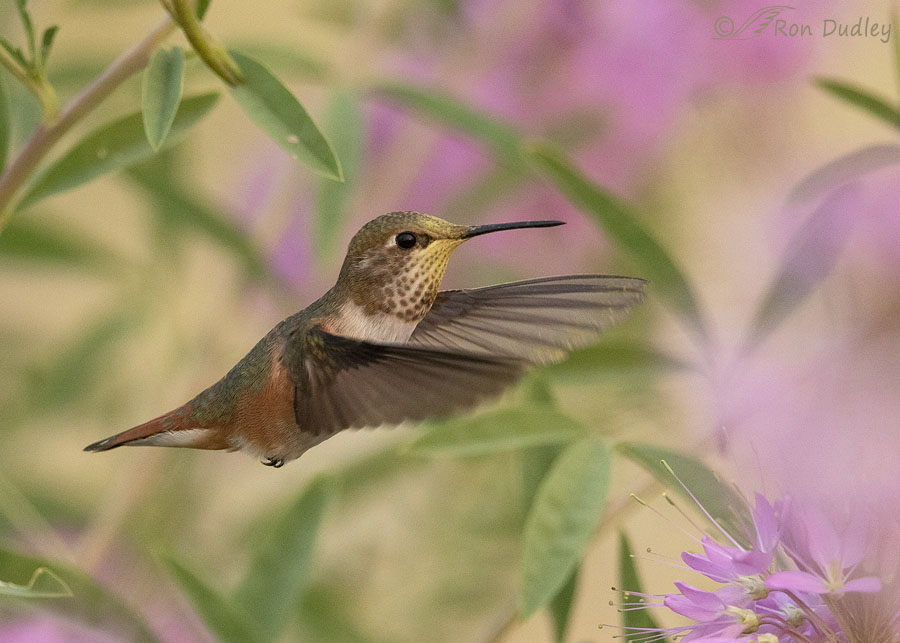
1/2000, f/5.6, ISO 1250, Canon 7D Mark II, Canon EF 500mm f/4L IS II USM + EF 1.4 III Extender, not baited, set up or called in
This one is a little different than the rest of them because the pink bee plant flowers play only a supporting role in the image. I think the photo looks a little like an oriental print, but then what do I know about oriental art…
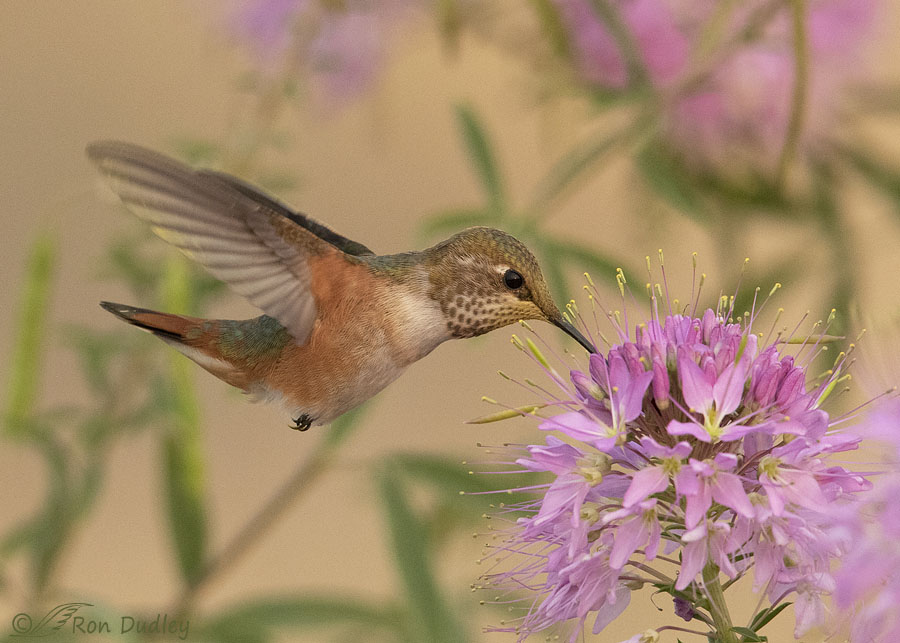
1/2000, f/5.6, ISO 1600, Canon 7D Mark II, Canon EF 500mm f/4L IS II USM + EF 1.4 III Extender, not baited, set up or called in
For some of my earlier shots, with the smoke so thick and the sun so low in the sky, I was getting a shutter speed of less than 1/1000. That just isn’t fast enough for hummers in flight so I was forced to increase my ISO to 1600. That helped but of course it tended to increase the digital noise in my images.
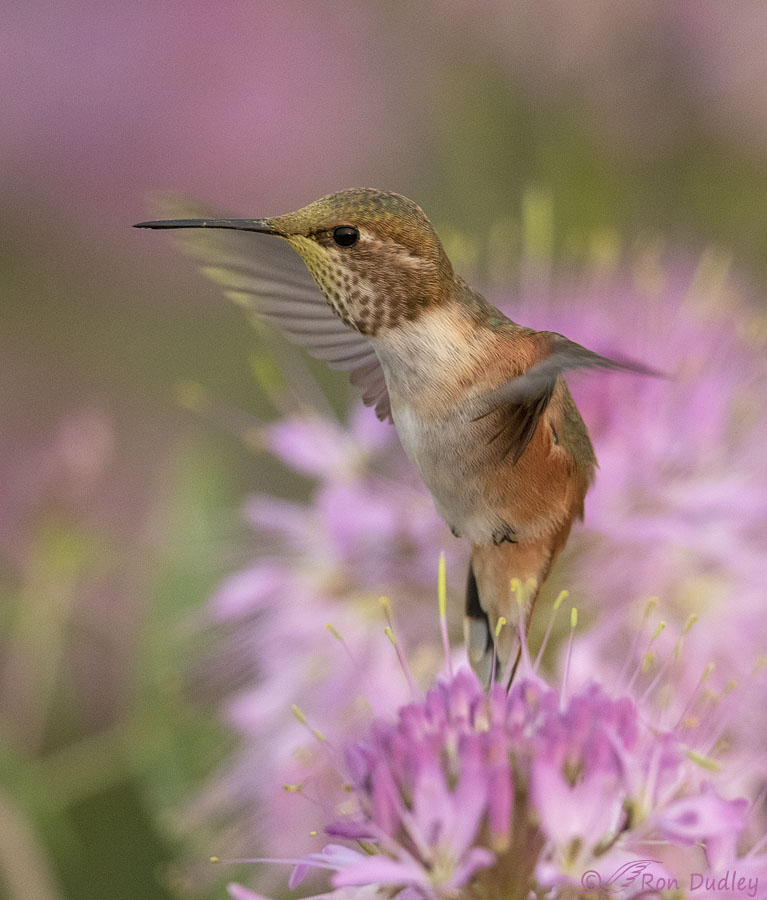
1/2000, f/5.6, ISO 1600, Canon 7D Mark II, Canon EF 500mm f/4L IS II USM + EF 1.4 III Extender, not baited, set up or called in
Not a great shot in some ways but I think it’s interesting because it almost looks like the bird is standing on its tail on the flower. Or perhaps dancing on it.
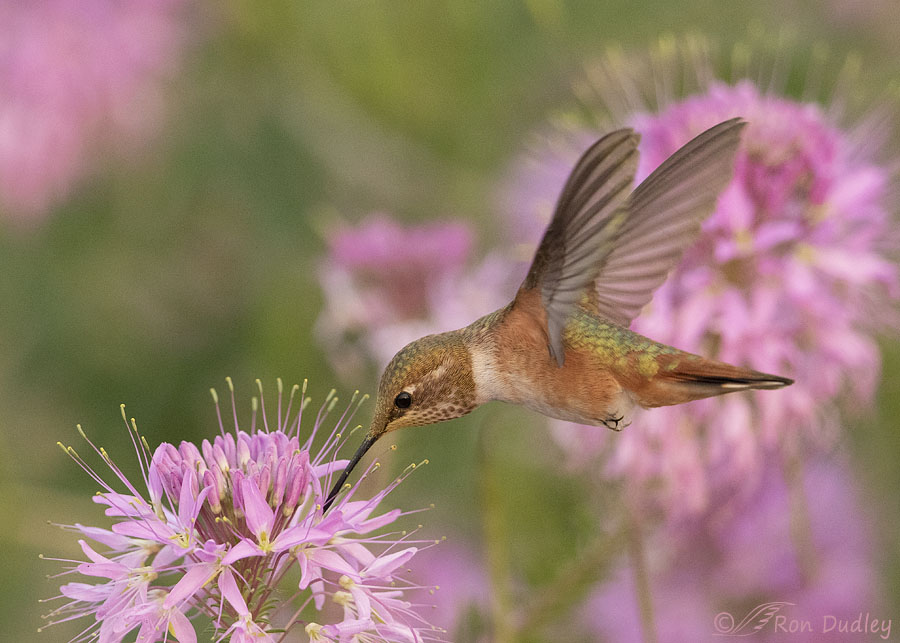
1/2000, f/5.6, ISO 1600, Canon 7D Mark II, Canon EF 500mm f/4L IS II USM + EF 1.4 III Extender, not baited, set up or called in
Another nectaring shot.
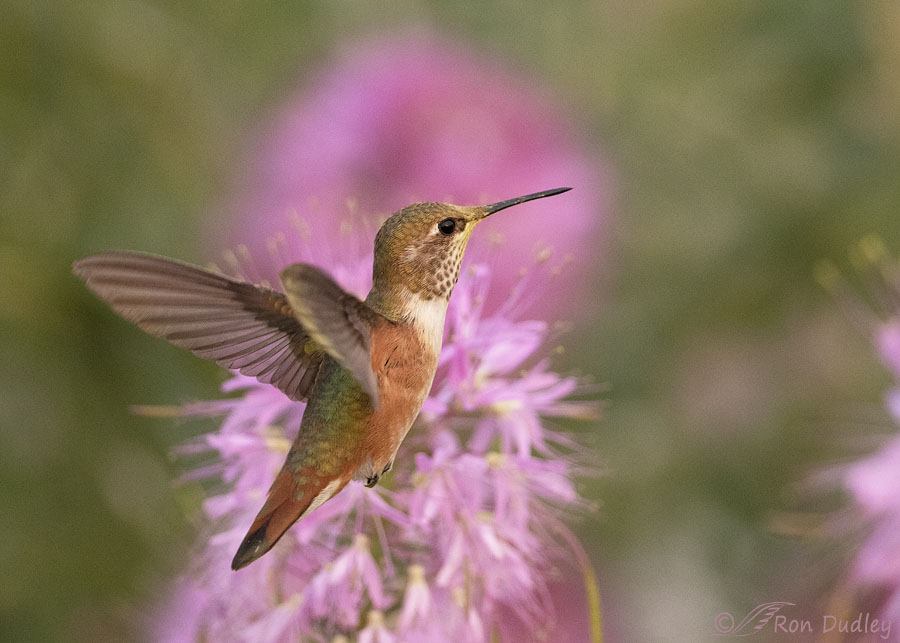
1/2000, f/5.6, ISO 1600, Canon 7D Mark II, Canon EF 500mm f/4L IS II USM + EF 1.4 III Extender, not baited, set up or called in
I think the 3D effect in this photo is pretty dramatic.
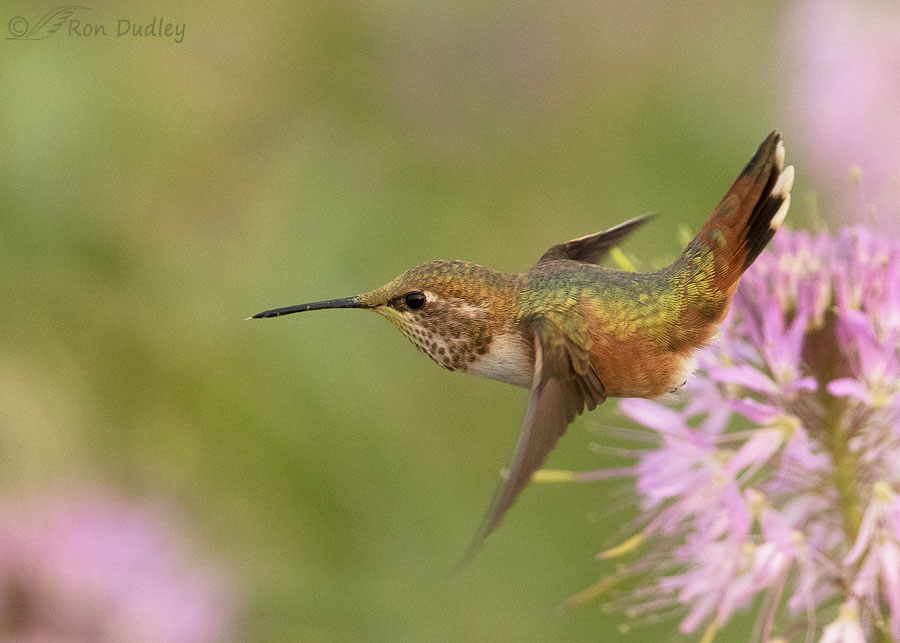
1/2000, f/5.6, ISO 1600, Canon 7D Mark II, Canon EF 500mm f/4L IS II USM + EF 1.4 III Extender, not baited, set up or called in
Here the bird was rotating its body in midair in order to fly away from the flower it had been feeding on. Abruptly changing direction like this resulted in an asymmetrical wing position that I don’t often see in my photos of hummers in flight. I was very lucky to get this one sharp, except for the wings of course.
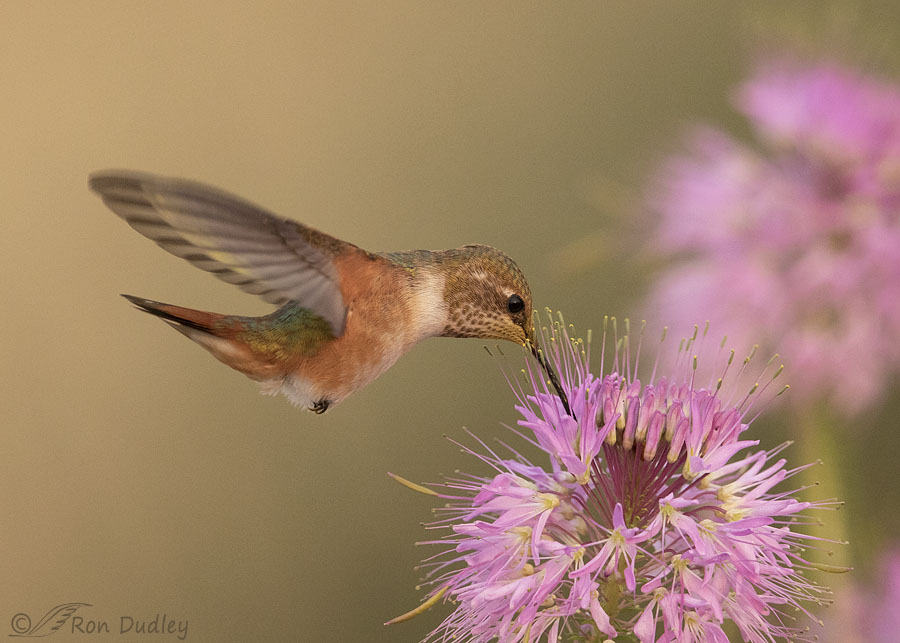
1/1600, f/5.6, ISO 1250, Canon 7D Mark II, Canon EF 500mm f/4L IS II USM + EF 1.4 III Extender, not baited, set up or called in
By now the sun had risen high enough that its light didn’t have to pass through quite so much smoke. So I decreased my ISO to 1250 which helped a little with noise in many of my later photos.
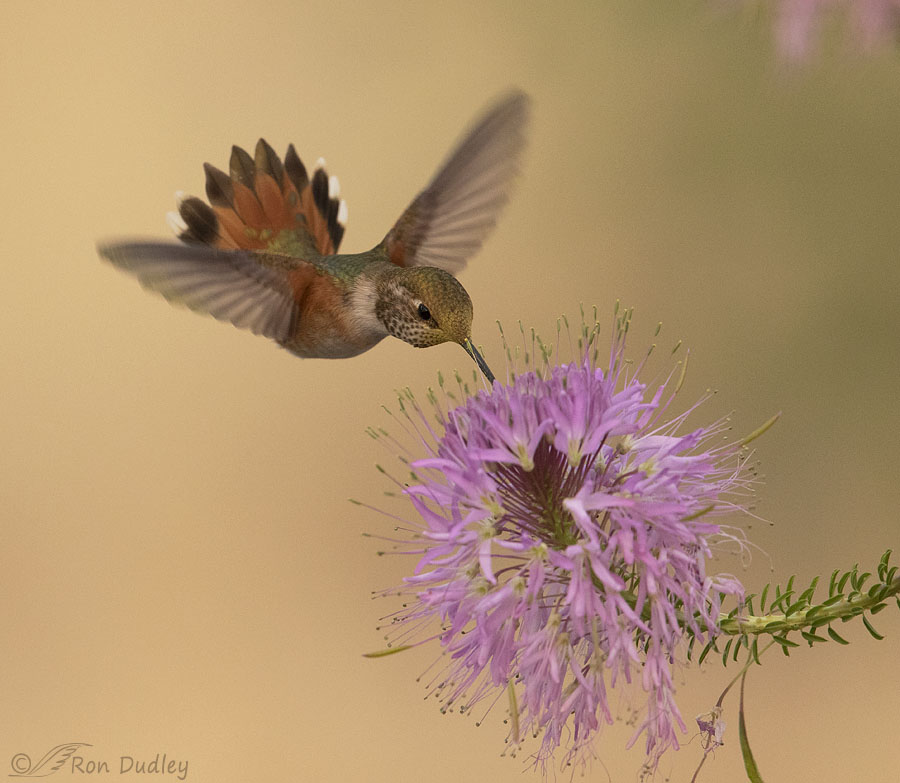
1/4000, f/5.6, ISO 1250, Canon 7D Mark II, Canon EF 500mm f/4L IS II USM + EF 1.4 III Extender, not baited, set up or called in
I’m including this last photo more for the flowers than the bird. This shot (combined with the previous one) gives the reader a pretty good sense of the structure of bee plant flower clusters, as described below by the USDA:
- “The nectar-filled blossoms are clustered in elongated racemes near the top portion of the stems and attract a diverse array of pollinators, including bees, butterflies, and wasps. Each flower has four petals and sepals and six long showy stamens. This species has a long blooming season: anytime from May thru September, depending on location and elevation. The fruits are distinctive podlike capsules, up to four inches long, and droop downward from elongated stalks.”
So there you have it, probably my last hummer photos of the season.
I say “last” because they’re leaving quickly, I probably won’t go out shooting again until the busy holiday season is over (I don’t do well in crowds) and even the hummers in my yard have almost completely disappeared. Yesterday I only saw a single Black-chinned Hummingbird show up at my feeder after weeks of having many of them.
I say “probably” because with birds I’ve learned to never say never.
Ron


I like them all, including the hummer in the last photo, in part because we can see the tail fanned out.
I’m curious about what exposure mode you use. You mentioned changing the ISO to get faster shutter speeds. Are you shooting aperture priority and tweaking ISO to get the shutter speed in the range you want? Have you considered using manual mode with auto-ISO. That’s what I have been using more and more for birds (I am not nearly as successful as you at getting good images). I still need to check what ISO is selected, but overall it seems a good way to go.
Love the photos and the technique info.
“Are you shooting aperture priority and tweaking ISO to get the shutter speed in the range you want?”
That’s exactly what I do, Duane. Always.
I’m of the (pretty strong) opinion that it doesn’t matter so much which method you use. They all have advantages and disadvantages. What really matters is that you choose one and use it exclusively, or almost exclusively, so that you truly master it – to the point you don’t have to think about what you’re doing, it comes as second nature.
When I’m shooting birds, speed is usually of the utmost importance. It takes time to think about which setting to use and what its effects are and more time to change it so I never switch back and forth and I know aperture priority extremely well. So I stick with it. If manual mode had been my choice I think I’d be photographing about as well as I do now. But if I used them both, switching back and forth in different situations, I’m almost positive I wouldn’t be.
That way I miss fewer shots and screw up fewer shots. That’s what works best for me but then I’m definitely a creature of habit.
“ I’m of the (pretty strong) opinion that it doesn’t matter so much which method you use. They all have advantages and disadvantages. What really matters is that you choose one and use it exclusively, or almost exclusively, so that you truly master it – to the point you don’t have to think about what you’re doing, it comes as second nature.”
That makes a lot of sense to me. With the limited time available for adjustments, being second nature will help immensely. I’m not there yet in terms of mastering it, but have been using one method exclusively, and I think it is helping me. Thanks, I appreciate your response.
Stunner of a finale — especially the flared tail in the last shot. As a musician, I can always hope for an encore (or two). 🙂
Delightful! 🙂
I have scrolled down. I have scrolled up. I have scrolled down again.
The third is definitely dancing.
Yet another wonderful series – even if it does stoke my hummer envy.
Thanks, EC. Living in Australia and having hummer envy must be tough. But then you have plenty of very special birds to take some of the sting out of it.
We do have lots of special birds (for which I am grateful). My greedy self still has hummer envy though – and for rather a lot of ‘your’ other birds too.
Wow! Is all I can say to these photos. Stunning! The pink flowers and the light are such perfect complements to the beautiful bird. Each picture is perfect in my eyes. What a tour-de-force – makes me want to get out and take some photos ASAP.
“makes me want to get out and take some photos”
Thanks, Joanne. Better do it soon if you have hummer photos in mind.
What a grand Grand Finsle that is (msybe)!,,.
Thanks, Patty.
Your photos of my favorite bird are magnificent. I still have hummers coming to my feeder that I enjoy so much. They are very competitive and don’t share the feeder with other hummers. Only once have I seen 2 hummers at the feeder at the same time.
I appreciate your commentary and your photos so much. Thank you.
Alice, eventually I had two hummers sharing the feeder at the same time, more than once, but it took a long time before I saw it happen.
Your probably-last-of-season hummers are sheer delight to my eyes (possibly in part because I am partial to pinks, especially in flowers)! The birds’ blurred-in-motion wings are so amazing to see here, as are the 6th and last images with the tail first upright and then flared out! What acrobatic little jewels they are …. ♥️
Happy Labor Day weekend, Ron, thanks for all your photographic labors so far this year! 😎
Thanks very much, Chris. Same to you!
Beautiful images. The colors, light and poses. I am missing the release of the 4 weathering at home. Haley will need to take care of them while I am away. They are fun to watch when released, they are so excited about everything. They lick and taste all plants and flowers and flit to every new distraction. There are still juveniles at the center who are not quite ready so I hope we have a warm fall for their future release. I have learned a lot about them the last four years working more intensely with them. They are the size of insects but their sense of curiosity and intelligence astounds me. They are so quick in their observations if you aren’t paying attention you miss seeing their calculations. I am now attuned to the differences in calls, hunger, fear, excitement, warning, challenge and of course battle cry. They have a scream of fear that sounds like Tinkerbell screaming. I can hear the difference in calls between the black chinned, broadtail and rufous. Watching them in weathering and release cages has been fascinating.
“They have a scream of fear that sounds like Tinkerbell screaming”
Very descriptive, April. I’m extremely jealous of how well you’ve learned their behaviors.
You’ve ended (maybe) your Hummingbird season with a grand finale👏 I haven’t seen any Rufous here for a while but the overwintering Anna’s remain with the males still chasing each from the feeder. The flared tail in the last photo made me smile; reminds me of a Turkey.
I see what you mean about the turkey resemblance, Lyle.
Spectacular, Ron! Simply spectacular! Thanks for sharing.
Thanks, Diane.
Spectacular! Thanks for sharing!
Charlotte Norton
Thank you, Charlotte.
So dainty … so lovely … like dancing!!!!!!
Thanks, Lois.
Fabulous photos any of which I would have given a great deal to have taken. Hopefully they and the memories of the day will tide you over until the hummers return.
They’ll help Pat but it’s still going to be a long winter without them.
Ah, as a west coaster exiled to the east coast I can really feel the pain of that “long winter” comment.
The third and last shots I love for the flight patterns, which I think I’ve seen on hummers, but they move so fast, i never know. Or knew. Now I know! The Rufus comes to our feeders and i often get a flash of that flaring tail. And once or twice while i watered my garden, a hummer has seemed to stand in air to get a bath. Thanks!
“they move so fast, I never know”
The magic of photography comes through again. Thanks, Sallie.
Love this series and the Rocky Mountain Bee plant. I think sometimes the motion blur helps a photo especially with hummingbirds. Will be sorry to see your hummingbirds leave you. We have the White-lined Sphinx Moths everywhere right now. The bats are eating them at night and we often find remnants of their wings on our front patio in the morning.
Now there’s a challenge for you Everett – photos of bats capturing moths in flight. In the dark… 🙂
Wow – that got me laughing for sure. That would be a challenge probably far above my abilities, but would sure be interesting to see.
Maybe time for an infrared camera… 🙂 The bats would show up but probably not the moths.
These are beautiful photos of a beautiful bird. The photos took my breath away.
Thank You,
Kaye
Thanks very much, Kaye.
Definitely a really nice series!
Thank you, Bruce.
You’ve produced a GRAND finale to this season ! To my taste, these are
the most beautiful hummer images of the whole summer, and all in one
collection…….it’s especially impressive, given the environmental conditions
that both you and your subjects were working in. Bravo !
Thanks very much, Kris. I guess wildfire smoke isn’t all bad… 🙂
I really love these photos. The soft pink and green of the Cleome, along with the sand-colored sky, is very artistic; has a real calming effect. I especially like the last photo where the bird’s tail is fanned open. And in the some of the other shots, her tiny feet are so cute!
Sarah, pink has never been a favorite color of mine but I’ve spent so much time at bee plants the last few years I’m becoming quite tolerant of it… 🙂
The tail, though, on that last photo is divine!
I agree, Suzanne. If it hadn’t been for that flared tail I might not have included the photo in today’s post.
Here in the piney woods of east Texas I have about 20 at my feeders. Only once have I seen a Rufous. We will have them through October as they travel to Rockport-Fulton which is their staging area before going across the gulf. Once we had a RTH winter over.
Hello from League City! I spend as much time as I can at Sandylands, the Watson Rare Plant Preserve in Warren, and the trails through the Big Thicket. You live in a wonderful spot!
Ann, I’ve never had that many at my feeder – about four at a time is tops.
WOW! All shots are beautiful to me! The bit of blur in the wings is NOT a distraction and the colors and body positions are wonderful “stop action”. 🙂 Last shot with the flared tail is especially appealing to me. 🙂
Accidently flushed 2 Great Blue Heron’s working a shrinking puddle in the creek this morning. :(. Think a female Common Merganser pretty well cleaned it out the other day tho she was having a helluva time with a fish that a a little too big. 😉
Thanks, Judy. I hope you get some water in that creek soon. Gotta cool those rocks off a little!
Your wonderful photos remind me of why we all love this little bird so much!
Thanks, Terri.
That photo with the asymmetrical wing position is terrific. I’ve never seen anything like that. Out of curiosity, I checked my files and found my last photos of hummingbirds in 2020 were taken on October 28. By that time, only a few still were around.
I’m glad you appreciate that shot, Shoreacres. So do I.
As I recall you live in Texas so I’d expect that you’d see hummers much later in the season than I do here in northern Utah.
That’s right: Texas. What a difference a few degrees of latitude can make!